Not mentioned in this otherwise positive story by Theo Milonopoulos in the Los Angeles Times on the myriad changes taking place in what was once a dreary and unsafe -at night- part of the nation's capital, is the tranformative effect on people's life of having a consistently good if-not-always-great Metro system.
It's the sole reason I was able to live in Arlington County, as close to Georgetown as I did, for almost 14 years, with never a thought to live farther out in the suburbs, and paid as much as I did for my place .
It gives people working in that part of D.C. the freedom to stay after work and socialize and have a life and be able to do things that don't revolve around parking, bars and restaurants, like the events at the Verizon Center.
Oddly, to me at least, the writer never specifically mentions the hearty pioneer role played by, of all actors, yes- the Hard Rock Cafe, in keeping a candle in the window.
For years, other than Ford's Theatre on that same block, there was nowhere to go at night where by day you had constant activity generated by neighbors like the FBI and the Federal Election Commission.
Frankly, having walked from near Capitol Hill or the National Gallery of Art over towards
the Metro Center area at night only a couple of thousand times, once I was in that general area, having turned off Pennsylvania Avenue, THE only consistent lighting on the side of that block of Ford's Theatre, the FEC, the FBI and The Hard Rock, was that provided by the McDonald's.
And that McDonald's was only there because unlike the geniuses in the Florida Marlins marketing office -as well as Jeffrey Loria and David Samson, who put the Marlins lone team store on Calle Ocho, instead of having it located in areas where their actual customers live and shop, like Pembroke Lakes Mall, Dadeland, Sawgrass or even a small ground floor store on Brickell Avenue towards the Greenberg Traurig building- they'd done their research and knew exactly how many people were in the area at any time of day.
More particularly, they knew the large number of chartered/tourists buses deposited there during the day for tours of the FBI and the House Where Lincoln Died.
Especially kids and their teachers/parents/chaperones.
Kids riding on buses for hours being dropped in front of a McDonald's is the retail equivalent of a ca$h-flow "Perfect Storm."
(More next week on the Marlins self-sabotaging marketing and stadium problems next week, replete with some facts and figueres and thoughts you haven't read elsewhere, which I've been keeping under wraps 'till after the season was over.
If you want to do some advanced reading on this subject which butress the points I've already written and kept in Draft for a few months, carefully read the Herald's recent story on the lack of any general interest bookstore within the city limits of the city of Miami, and why that is so.)
Not mentioned, for reasons that seem rather obvious to me, is the extent to which many of the then-existing bad probelms were compunded by the few actions the city did take.
That these plans and strategies often seemed poorly-thought out at first, or lacked what would seem like anything resembling an appropriate level of follow-up scrutiny or a self-correcting mechanism, like a sunshine provision, so that if they were judged unsuccessful, they'd be left in place permanently, only made public policy types me who actually knew the area shake our heads in dismay.
Not unlike South Florida, where there's always been an argument that methods and strategies that work successfully elsewhere either can't be tried, or are ruled out of consideration here immeditaely because of some sort of some crazy non-existant 'South Florida exceptionalism,' there was an element in D.C. that wanted to be seen succeeeding without asking for the the help of those who had already knew and had learned the lessons, and seen them replicated successfully elsewhere.
Here's the situation: by the early '90's, despite the election of a new mayor -Sharon Pratt Kelly-elected in large part to regain control of the city from the sort of corrupt, criminal and mendacious elements that held sway over lots of neighborhoods, is the extent to which the DC Public Library branch there had become an encampment for the homeless and drug dealers, which was never more apparent than when you walked thru the restroom door.
The stench would knock you out.
People walked around like zombies.
At night, because the city trusted engineers more than they did common sense, they foolishly
blocked off an existing east-west street that funneled traffic thru the heart of the city.
Their intent was to make the area near the DC library branch more pedestrian-friendly, but because they did so without considering what the corresponding effect would be on local businesses and their employees, not to mention, tourists, the safety situation became markedly worse, because police cars could no longer cruise by regularly.
The city essentially 'gave up' on the block.
_____________________________________________________
http://www.latimes.com/news/nationworld/nation/la-na-pennquarter22nov22,0,2767878.story?coll=la-tot-national&track=ntothtml
Los Angeles Times
No end in sight with D.C.'s makeover boom
The once-blighted Penn Quarter is revitalized so rapidly that the city is under pressure to keep capitalizing on the area.
By Theo Milonopoulos, Los Angeles Times Staff Writer
November 22, 2007
WASHINGTON — As secretary of State in the late 1700s, Thomas Jefferson laid out the initial design, including "public walks" for the area between the Capitol and what is now known as the White House. The capital's first city planner, Pierre L'Enfant, envisioned a grand boulevard, home to academies and lecture halls to enlighten and entertain, connecting the legislative and executive branches of the government.
Instead, Pennsylvania Avenue and the blocks just north of it became lined with boardinghouses and hotels where members of Congress resided. The open-air Center Market sold foodstuffs, manufactured goods and even slaves. Gambling establishments and music halls, not lecture halls, were the most popular forms of entertainment.
And like many center-city areas across the country, this one fell on hard times over the years. As fewer shoppers ventured downtown, preferring modern suburban malls closer to home, the city's most prestigious department stores, Garfinckel's and Woodward & Lothrop, closed their doors. By the mid-1990s, panhandlers and prostitutes roamed Jefferson's "public walks," and Ford's Theatre, the site of President Lincoln's assassination, was surrounded by blocks of boarded-up buildings and graffiti-covered storefronts.
"It was dreary," said Anthony A. Williams, Washington's mayor from 1999 through 2006. "I thought it was embarrassing that the nation's capital, within blocks of the White House, had drifted into despair."
Now this once-blighted area, rechristened Penn Quarter, has been transformed into a thriving business district with high-end residential developments, a vibrant night life and the third-most lucrative downtown office market in the country. But this urban renaissance has revitalized the area so quickly that the city and developers are under pressure to continue capitalizing on downtown's high-priced commercial market while meeting the growing demands of residents for an affordable and livable environment.
The 138 blocks of the Downtown DC Business Improvement District, which includes Penn Quarter, have nearly 100 restaurants, along with boutiques, galleries, museums and theaters. Among its attractions are the restored Old Patent Office Building, which houses the National Portrait Gallery and the Smithsonian's American art collection; the new Harman Center for the Arts, which marries the classical Shakespeare Theatre Co. with a 21st century performance space; and the popular International Spy Museum, which explores the history and tradecraft of intelligence and is headed by a 36-year veteran of the CIA.
"It's a vibrant, inviting and bright place," said Richard H. Bradley, executive director of the Downtown DC BID.
That wasn't the case 10 years ago, said Miles E. Groves, director of the Downtown Neighborhood Assn. The bustle of business during the day drifted into desolation at dusk, as drug dealers and prostitutes took over the streets. "It was a place where you didn't want to be at night," Groves said.
As mayor, Williams sought to reverse this downward spiral through the Downtown Action Agenda, a public-private partnership. Its goal was to build off the district's economic boom to invigorate a strong residential, retail and entertainment destination.
The Downtown DC BID worked with the city and developers, using tax abatements, bonds and land subsidies to encourage investment in residential projects as a means of supplementing the already strong office market, said Gerry Widdicombe, the group's economic development director.
Anchoring this development was the MCI Center, a $200-million sports and entertainment facility that opened in 1997. Now known as the Verizon Center, and home to the NBA's Wizards and the NHL's Capitals, the building will have welcomed over 24 million patrons when it celebrates its 10th anniversary next month.
"We used to sit around and wait for federal handouts . . . until we finally started to do what other cities do: Invest in themselves," Widdicombe said.
From 1996 to 2006, according to the BID, that investment totaled $8.2 billion -- for 16.9 million square feet of new and renovated office space and 3,308 residential units. Jobs in the area grew to 177,000 in 2006, from 120,000 a decade earlier. For fiscal 2007 alone, the area generated $740 million in local taxes and other revenue.
But the rapid growth of the office market has outpaced the ability of the city and the developers to deliver some essential residential services, Groves said. There has been no comprehensive survey of the area's demographics since the 2000 census, which Groves said ignored the dramatic downtown population boom and prevented the city from getting a clear picture of the downtown living environment.
"We have a mixed-use environment that is more focused on commercial development than on the fact people live here," Groves said -- noting, for example, that there is no full-service grocery store. In addition, he said, the area's growing popularity has pushed out many of the small shops and galleries that had been enticed by cheap rents."
It makes it very difficult for the small and independent folks to survive," Groves said.
The city and the developers are working to iron out conflicts between commercial occupants and residents over such issues as better street lighting and time restrictions on construction and trash collection, Widdicombe said. BID employees provide some extra sanitation and street services, and plans are in place for a Safeway as a part of CityVista, a new complex of retail shops, condominiums and rental apartments.
Bradley said that 20% of the residences at CityVista will be classified as "affordable housing" for low-income individuals, with rentals below the market rate. The price of new one- and two-bedroom condominiums averaged about $350,000 to $650,000 in 2006, according to the BID. Shopping remains an issue, said Karen M. Sibert, the BID's communications director. Even though several national stores, including Banana Republic, Barnes & Noble and Bed Bath & Beyond have opened downtown, the area still lacks a centralized shopping district.
Rather than having stores disjointedly dotting the ground floors of office buildings, Sibert said, the BID hopes to create several contiguous blocks of retail to help restore downtown's shopping core.
Three large retailers -- clothiers H&M and Zara and furniture store West Elm -- have taken ground-floor space in the restored Woodward & Lothrop building on F Street, the heart of the city's traditional retail area.
The BID celebrated its 10th anniversary last week with a gala at the Harman Center. These days there are few vacant properties ripe for redevelopment in Penn Quarter, but Bradley said he did not see the renewal slowing down.
"We are now a very different kind of place a decade later," he said.
theo.milonopoulos@latimes.com
Subscribe to:
Post Comments (Atom)
In the Heart of a Great Country, Beats the Soul of Hoosier Nation
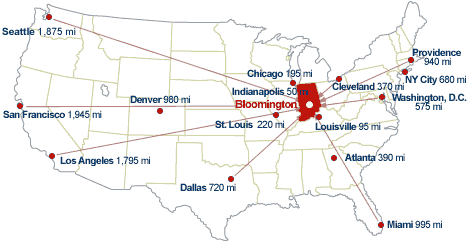
"In the Heart of a Great Country, Beats the Soul of Hoosier Nation." -South Beach Hoosier, 2007
#IUBB, #bannersix
The South Florida I Grew Up In
Excerpts from Joan Didion's Miami, 1987, Simon & Schuster:
In the continuing opera still called, even by Cubans who have now lived the largest part of their lives in this country, el exilo, the exile, meetings at private homes in Miami Beach are seen to have consequences. The actions of individuals are seen to affect events directly. Revolutions and counter-revolutions are framed in the private sector, and the state security apparatus exists exclusively to be enlisted by one or another private player. That this particular political style, indigenous to the Caribbean and to Central America, has now been naturalized in the United States is one reason why, on the flat coastal swamps of South Florida, where the palmettos once blew over the detritus of a dozen failed booms and the hotels were boarded up six months a year, there has evolved since the early New Year's morning in 1959 when Fulgencio Batista flew for the last time out of Havana a settlement of considerable interest, not exactly an American city as American cities have until recently been understood but a tropical capital: long on rumor, short on memory, overbuilt on the chimera of runaway money and referring not to New York or Boston or Los Angeles or Atlanta but to Caracas and Mexico, to Havana and to Bogota and to Paris and Madrid. Of American cities Miami has since 1959 connected only to Washington, which is the peculiarity of both places, and increasingly the warp...
"The general wildness, the eternal labyrinths of waters and marshes, interlocked and apparently neverending; the whole surrounded by interminable swamps... Here I am then in the Floridas, thought I," John James Audobon wrote to the editor of The Monthly American Journal of Geology and Natural Science during the course of an 1831 foray in the territory then still called the Floridas. The place came first, and to touch down there is to begin to understand why at least six administations now have found South Florida so fecund a colony. I never passed through security for a flight to Miami without experiencing a certain weightlessness, the heightened wariness of having left the developed world for a more fluid atmosphere, one in which the native distrust of extreme possibilities that tended to ground the temperate United States in an obeisance to democratic institutions seemed rooted, if at all, only shallowly.
At the gate for such flights the preferred language was already Spanish. Delays were explained by weather in Panama. The very names of the scheduled destinations suggested a world in which many evangelical inclinations had historically been accomodated, many yearnings toward empire indulged...
In this mood Miami seemed not a city at all but a tale, a romance of the tropics, a kind of waking dream in which any possibility could and would be accomodated...
Hallandale Beach Blog
http://www.hallandalebeachblog.blogspot.com/
Hallandale Beach Blog is where I try to inject or otherwise superimpose a degree of accountability, transparency and much-needed insight onto local Broward County government and public policy issues, which I feel is sorely lacking in local media now, despite all the technological advances that have taken place since I grew-up in South Florida in the 1970's. On this blog, I concentrate my energy, enthusiasm, anger, disdain and laser-like attention primarily on the coastal cities of Aventura, Hollywood and Hallandale Beach.
IF you lived in this part of South Florida, you'd ALREADY be in stultifying traffic, be paying higher-than-necessary taxes, and be continually musing about the chronic lack of any real accountability or transparency among not only elected govt. officials, but also of City, County and State employees as well. Collectively, with a few rare exceptions, they couldn't be farther from the sort of strong results-oriented, work-ethic mentality that citizens here deserve and are paying for.
This is particularly true in the town I live in, the City of Hallandale Beach, just north of Aventura and south of Hollywood. There, the Perfect Storm of years of apathy, incompetency and cronyism are all too readily apparent.
It's a city with tremendous potential because of its terrific location and weather, yet its citizens have become numb to its outrages and screw-ups after years of the worst kind of chronic mismanagement and lack of foresight. On a daily basis, they wake up and see the same old problems again that have never being adequately resolved by the city in a logical and responsible fashion. Instead the city government either closes their eyes and hopes you'll forget the problem, or kicks them -once again- further down the road.
I used to ask myself, and not at all rhetorically, "Where are all the enterprising young reporters who want to show through their own hard work and enterprise, what REAL investigative reporting can produce?"
Hearing no response, I decided to start a blog that could do some of these things, taking the p.o.v. of a reasonable-but-skeptical person seeing the situation for the first time.
Someone who wanted questions answered in a honest and forthright fashion that citizens have the right to expect.
Hallandale Beach Blog intends to be a catalyst for positive change. http://www.hallandalebeachblog.blogspot.com/
http://www.hallandalebeachblog.blogspot.com/
Hallandale Beach Blog is where I try to inject or otherwise superimpose a degree of accountability, transparency and much-needed insight onto local Broward County government and public policy issues, which I feel is sorely lacking in local media now, despite all the technological advances that have taken place since I grew-up in South Florida in the 1970's. On this blog, I concentrate my energy, enthusiasm, anger, disdain and laser-like attention primarily on the coastal cities of Aventura, Hollywood and Hallandale Beach.
IF you lived in this part of South Florida, you'd ALREADY be in stultifying traffic, be paying higher-than-necessary taxes, and be continually musing about the chronic lack of any real accountability or transparency among not only elected govt. officials, but also of City, County and State employees as well. Collectively, with a few rare exceptions, they couldn't be farther from the sort of strong results-oriented, work-ethic mentality that citizens here deserve and are paying for.
This is particularly true in the town I live in, the City of Hallandale Beach, just north of Aventura and south of Hollywood. There, the Perfect Storm of years of apathy, incompetency and cronyism are all too readily apparent.
Sadly for its residents, Hallandale Beach is where even the easily-solved or entirely predictable quality-of-life problems are left to fester for YEARS on end, because of myopia, lack of common sense and the unsatisfactory management and coordination of resources and personnel.
It's a city with tremendous potential because of its terrific location and weather, yet its citizens have become numb to its outrages and screw-ups after years of the worst kind of chronic mismanagement and lack of foresight. On a daily basis, they wake up and see the same old problems again that have never being adequately resolved by the city in a logical and responsible fashion. Instead the city government either closes their eyes and hopes you'll forget the problem, or kicks them -once again- further down the road.
I used to ask myself, and not at all rhetorically, "Where are all the enterprising young reporters who want to show through their own hard work and enterprise, what REAL investigative reporting can produce?"
Hearing no response, I decided to start a blog that could do some of these things, taking the p.o.v. of a reasonable-but-skeptical person seeing the situation for the first time.
Someone who wanted questions answered in a honest and forthright fashion that citizens have the right to expect.
Hallandale Beach Blog intends to be a catalyst for positive change. http://www.hallandalebeachblog.blogspot.com/
Hallandale Beach's iconic beachball-colored Water Tower, between beach and A1A/South Ocean Drive
Hollywood in Cartoons, The New Yorker

"Gentlemen, I am happy to announce that as of today we are closing down our Washington news bureau and moving the entire operation to L.A."
Hollywood in Cartoons, The New Yorker
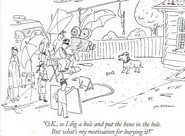
"O.K., so I dig a hole and put the bone in the hole. But what's my motivation for burying it?"
Hollywood in cartoons, 10-21-06 Non-Sequitur by Wiley, www-NON-SEQUITUR.COM

The Magic of Hollywood: A motion has been put forth that we should seek to create rather than imitate. All in favor of killing this silly notion, nod in mindless agreement...
Miami Dolphins
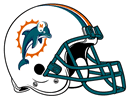
South Beach Hoosier's first Dolphin game at the Orange Bowl came in Dec. 1970, aged 9, a 45-3 win over Buffalo that propelled them into their first ever playoff appearance.
Sebastian the Ibis, the Spirited Mascot of the University of Miami Hurricanes

Before going to my first U-M game at the Orange Bowl in 1972, a friend's father often would bring me home an extra 'Canes game program. That's how I came to have the Alabama at U-M game program from Nov. 16, 1968, which was the first nationally-televised college football night game in color. (A 14-6 loss to the Crimson Tide.) After that first ballgame against Tulane, as l often did for Dolphin games if my father wasn't going, I'd get dropped off at the Levitz parking lot near the 836 & I-95 Cloverleaf in NMB, and catch a Dade County Park & Ride bus, going straight to the Orange Bowl. Onboard, I'd get next to the window and listen to WIOD's pre-game show on my Radio Shack transistor radio. A few times, I was just about the only person onboard besides the bus driver, which was alright by me. Once at the Orange Bowl, if I didn't already have a ticket, I'd buy a game program for myself and one or two for friends or teachers before heading to the ticket window, since you usually couldn't find a program vendor once inside. I probaly had a friend or my father with me for just under 40% of the U-M games I ever went to, but you have to remember that the team, though blessed with several talented players, like Chuck Foreman and Burgess Owens, was just so-so to average at best, and the games were usually played on Friday nights, so it wasn't exactly high on everyone's list of things to do. Depending upon the opponent, if I was alone, I'd often have entire areas of the Orange Bowl to myself. (Wish I had photos of that now!) For instance, I had a good portion of the East (open) End Zone to myself against Oklahoma in the mid-70's, when the Boomer Schooner and the Schooner Crew went out on the field after an Oklahoma TD, and the Schooner received an unsportsmanlike conduct penalty from the refs, as would happen years later in an Orangle Bowl Classic game. (Against FSU?) I was there for the wins and losses under Pete Elliott, Carl Selmer & Lou Saban, and the huge on-field fight in '73 when under eventual national champion Notre Dame (under Ara Parseghian), they called a time-out with less than a minute to go, and already up 37-0. Their rationale? To score another TD and impress the AP football writers; final score 44-0. Well, they got their wish and beat Alabama 24-23 for the title at the Sugar Bowl. A year later, thanks to my Mom's boss, she and I saw Ara's last game as head coach of the Irish in the Orange Bowl Game from the East End Zone -in front of the Alabama cheerleaders!!!- in an exciting 13-11 Notre Dame win over Alabama and Bear Bryant, a rematch of the '73 national title game. I was also present for the U-M's huge 20-15 win under Pete Elliott against Darrel Royal's Texas Longhorns, the week Sports Illustrated's College Football preview issue came out with Texas on the cover, below. I was also present for lots of wins against schools called College of the Pacific, UNLV and Cal-Poly San Luis Obsispo, which I'd then never heard of before.
Miami Dolphins Cheerleaders, April 28, 2007

Photo by Mario J. Bermudez. April 28, 2007 at Dolphins NFL Draft Party at Dolphin HQ, Davie, FL
Of cheerleaders past and present
Given South Florida's unique version of the melting pot -con salsa- demographics and mindset, these women in the photo above are surely what most South Floridians would consider attractive women. But for this observer, who's spent hours & hours at IU cheerleader tryouts and who has known dozens of cheerleaders -and wannabes- in North Miami Beach, Bloomington, Evanston and Washington, D.C., the whole time I was watching these members of the Dolphins' squad perform, I couldn't help but compare them and their routines to those of some IU friends of mine who ALWAYS showed true Hoosier spirit & enthusiasm.
Sitting at my table right near the stage and still later, while watching the long lines of Dolphin fans of all ages waiting to snap photos of themselves with the cheerleaders, I couldn't help but think about those friends who always left me and other Hoosier fans feeling positive & optimistic.
Was there anyone I saw in Davie who possessed these valuable intangibles: the dancing precision of IU Red Stepper -and Captain- Gail Amster, my talented and spirited Phi Beta Kappa pal from Deerfield (IL), who always sat next to me in our Telecom. classes as we took turns entertaining the other; the ebullient spirit & energy of two Hoosier cheerleaders -and captains- from Bloomington, Wendy (Mulholland) Moyle & Sara Cox; the hypnotic, Midwestern, girl-next-door sexiness of Hoosier cheerleader Julie Bymaster, from Brownsburg; or, the adorable Southern girl-next-door appeal of former Hoosier Pom squader Jennifer Grimes, of Louisville, always such a clear distraction while sitting underneath the basket?
Nope, not that I could see. But then they were VERY tough acts to follow!!!
And that's not to mention my talented & spirited friends like Denise Andrews of Portage, Jody Kosanovich of Hammond & Linda Ahlbrand of Chesterton, all of whom were dynamic cheerleaders -and captains- at very large Hoosier high schools that were always in the championship mix, with Denise's team winning the Ind. football championship her senior year when she was captain -just like in a movie. That Denise, Jody & Linda all lived on the same dorm floor, just three stories above me at Briscoe Quad our freshman year, was one of the greatest coincidences -and strokes of luck for me!- that I could've ever hoped for.
You could hardly ask for better ambassadors of IU than THESE very smart, sweet and talented women. In a future SBH post, I'll tell the story of one of the greatest Hoosiers I ever met, the aforementioned Wendy Mulholland, the Bloomington-born captain and emotional heart of the great early '80's IU cheerleading squads, and the daughter of Jack Mulholland, IU's former longtime Treasurer. The acorn doesn't fall far from a tree built on a foundation of integrity & community service!
(After he retired, Mr. Mulholland was the first executive director of the Community Foundation of Bloomington and Monroe County. I used to joke with Wendy that her dad's name was the one that was permanently affixed to the bottom of my work-study checks for years, while I worked at the Dept. of Political Science's Library, first, at the Student Building in the old part of campus, and then later, after it was refurbished, in magnificent Woodburn Hall, my favorite building on campus.)
In that future post, I'll share some reflections on Wendy's great strength of character and personality; my intentions of returning to Bloomington a few weeks before Fall '82 classes started, so I could help Wendy train and work-out to rehab her knee, so she'd feel confident in trying-out for the squad again, following a bad knee injury that'd left her physically-unable to try-out for the squad the previous spring, a big disappointment to those of us who cared about both Wendy and the team; my incredulity at, quite literally, running into Wendy while walking down a sidewalk one afternoon a few years later in Evanston, IL, when we were astonished to discover we were both living there, with me trying to hook on with a Windy City advertising agency, and Wendy then-attending Kellogg (KGSM) at Northwestern, right when the WSJ had named Kellogg the #1 Business School in the country.
I'll also share a story about Wendy performing a true act of kindness towards me in 1982, when I was having a real emergency, and she went above-and-beyond what I had any logical reason to expect. Yet, Wendy, along with her very helpful dad, Jack, came through for me when I was in a very bad time crunch. I've never forgotten Wendy's kindness towards me, and her true Hoosier spirit.
There's NOTHING I wouldn't do for Wendy Mulholland.
It's All About "The U"

South Beach Hoosier's first U-M football game at the Orange Bowl was in 1972, age 11, against Tulane in the infamous "Fifth Down" game. In order to drum up support and attendance for the U-M at the Orange Bowl, that game had a promotion whereby South Florida kids who were school safety patrols could get in for free IF they wore their sash. I did. Clearly they knew that it was better to let kids in for free, knowing their parents would give them money to buy food and souvenirs, perhaps become a fan and want to return for future games. The ballgame made an interesting impression on The New York Times, resulting in this gem from the "View of Sport" column of Oct, 14, 1990, labeled 'Fifth Down or Not, It's Over When It's Over.' -"In 1972, aided by a fifth-down officiating gift in the last moments of the game, Miami of Florida defeated Tulane, 24-21. The country and the world was a much different place that fall because The New York Times took time and space to editorialize on the subject. ''Is it right for sportsmen, particularly young athletes, to be penalized or deprived of the goals for which they earnestly competed because responsible officials make mistakes? The ideal of true sportsmanship would be better served if Miami forfeited last week's game.' South Beach Hoosier hardly needs to tell you that this was YET another New York Times editoral that was completely ignored!
The issue I took with me the night of U-M's 20-15 upset of #1 Texas at the Orange Bowl
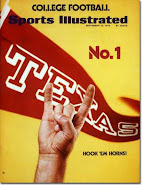
College Football, Texas No. 1, Hook 'em Horns, Sept. 10, 1973. Living in North Miami Beach in the '70's, my Sports Illustrated usually showed up in my mailbox on the Thursday or Friday before the Monday cover date. And was read cover-to-cover by Sunday morning.
The Perfect Storm
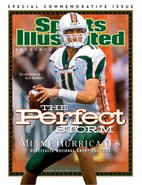
U-M QB Ken Dorsey, Miami Hurricanes Undefeated National Champions 2001, Jan. 2002
Miami's Romp in the Rose
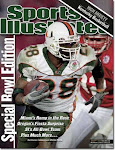
Miami running back Clinton Portis, Jan. 7, 2002
Why the University of Miami should drop football
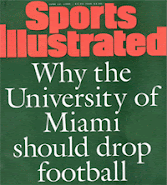
June 12, 1995
REVENGE!
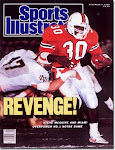
Steve McGuire and Miami Overpower No.1 Notre Dame, Dec. 4, 1989
How Sweet It Is!
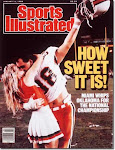
Miami Whips Oklahoma For The National Championship, Pictured: Dennis Kelleher, Jan. 11, 1988
My, Oh My, Miami!
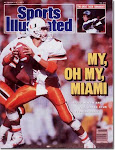
Steve Walsh and the Canes Stun FSU, Oct. 12, 1987
Why Is Miami No. 1?

QB Vinny Testaverde, Nov. 24, 1986
Miracle In Miami
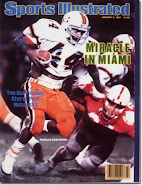
The Hurricanes Storm Past Nebraska, Halfback Keith Griffin, Jan. 9, 1984
Special Issue: College Football
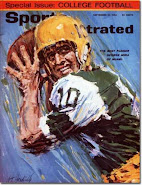
The Best Passer, George Mira of Miami, Sept. 23, 1963
1984 College & Pro Spectatcular
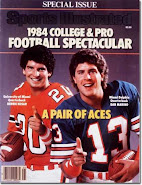
A Pair Of Aces: U-M QB Bernie Kosar & Miami Dolphin QB Dan Marino, Sept. 5, 1984
Pro Football Hall of Fame Special Issue

Dan Marino, Class of 2005, Aug. 2005
FACES OF THE NFL
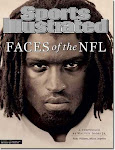
A Portfolio by Walter Iooss Jr., Ricky Williams, Miami Dolphins, Dec. 9, 2002
Coming Back
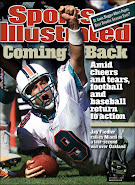
Jay Fiedler rallies Miami to a last-second win over Oakland, Oct. 1, 2001
Dan's Last Stand
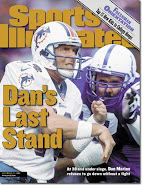
At 38 and under siege, Dan Marino refuses to go down without a fight, Dec. 13, 1999
The War Zone
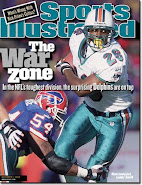
In the NFL's toughest division, the surprising Dolphins are on top, Lamar Smith, Dec. 11, 2000
Down and Dirty
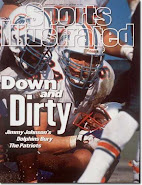
Jimmy Johnson's Dolphins Bury The Patriots, Steve Emtman, Sept. 9, 1996
The Sunshine Boys

Now Playing in Miami: The Dan Marino and Jimmy Johnson Show, May 11, 1996
HOT & NOT
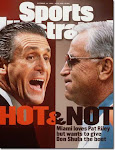
Miami loves Pat Riley but wants to give Don Shula the boot, Dec. 11, 1995
NFL PREVIEW 1995
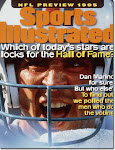
Which of today's stars are locks for the Hall of Fame? Dan Marino for sure. But who else? To find out, we polled the men who do the voting. Sept. 14, 1995
Sportsman Of The Year
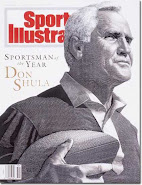
Don Shula, Dec. 20, 1993
Dan The Man
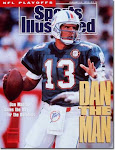
Dan Marino Saves The Day For The Dolphins, Jan. 14, 1991
Dangerous Dan
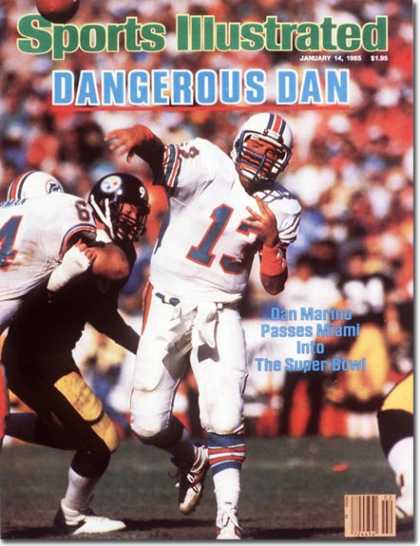
Dan Marino Passes Miami Into The Super Bowl, Jan. 14, 1985
Super Duper!

Wide Receiver Mark Duper Of The Undefeated Dolphins, Nov. 19, 1984
Air Raid! Miami Bombs Washington
+Sep+10,+1984.jpg)
Mark Clayton (burning Darryl Green) Sept. 10, 1984
Rookies On The Rise
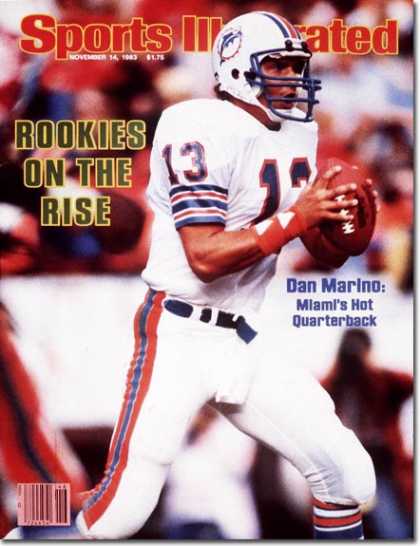
Dan Marino: Miami's Hot Quarterback, Nov. 14, 1983
New Life In The WFL
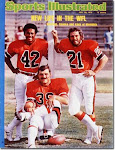
Warfield, Csonka and Kiick of Memphis, July 28, 1975
Zonk! Miami Massacres Minnesota
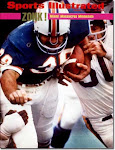
Larry Csonka, Jan. 21, 1974
Pro Football, Miami Is Rough And Ready

Larry Csonka & Bob Griese, Sept. 17, 1973
Miami All The Way
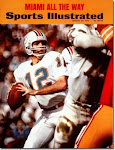
Bob Griese, Jan. 22, 1973
It's Miami and Washington
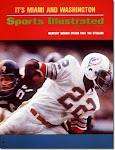
Mercury Morris Speeds Past The Steelers, Jan. 8, 1973
Kiick and Csonka, Miami's Dynamic Duo

Larry Csonka & Jim Kiick, Aug. 7, 1972
Sudden Death at Kansas City
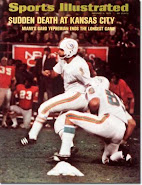
Miami's Garo Yepremian Ends the Longest Game; (kneeling) placekick holder Karl Noonan, Jan. 3, 1972
New Pro in a New Town

Miami's Frank Emanuel, Aug. 8, 1966
Old-style "Obie" the Orange Bowl Committee mascot

The iconic image I grew-up with in Miami, before FedEx got into the picture

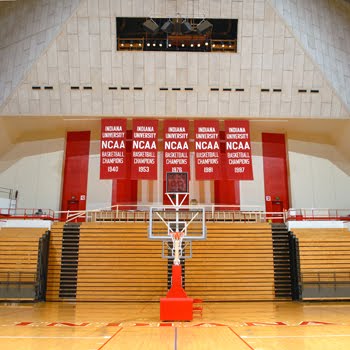

No comments:
Post a Comment